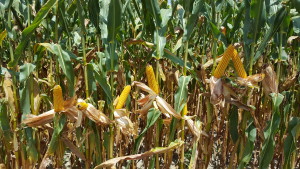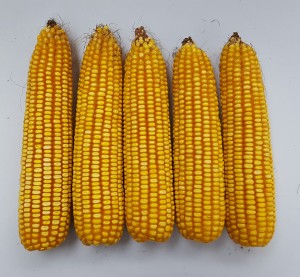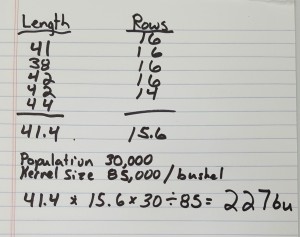 Farmers like to walk their corn fields preharvest and gather estimates of potential yields. This information can be used to estimate hauling, storage, forward sales, cash flow, and many other reasons. We know better than to “count our chickens before they hatch,” but we also have to be prepared for harvesting. The University of Illinois pioneered a corn yield estimate method that is very popular. I recently completed this process on a local farm looking at an excellent crop of Pioneer 1602. These warm dry seasons typically lead to our best corn crops, when good irrigation practices are used. Factors leading to high yield in dry years include absence of leaching rainfall events, high sunlight and photosynthesis, and lower disease levels.
Farmers like to walk their corn fields preharvest and gather estimates of potential yields. This information can be used to estimate hauling, storage, forward sales, cash flow, and many other reasons. We know better than to “count our chickens before they hatch,” but we also have to be prepared for harvesting. The University of Illinois pioneered a corn yield estimate method that is very popular. I recently completed this process on a local farm looking at an excellent crop of Pioneer 1602. These warm dry seasons typically lead to our best corn crops, when good irrigation practices are used. Factors leading to high yield in dry years include absence of leaching rainfall events, high sunlight and photosynthesis, and lower disease levels.
Here are the methods as described by University of Illinois:
Walk to a predetermined spot in the field (to avoid bias), and count the number of good ears in 1/1,000 of an acre (17ft 5in in 30-inch rows or 14ft 6in in 36-inch rows). Take random ears from the row section that was counted. To avoid using only good ears, take a pre determined set of ears. (For consistency, I like to take ear number 1,3,5,7 and 11). Count the number of rows of kernels and the number of kernels per row on each ear. Multiply these two numbers together for each ear, then average this kernel count for the three ears. Take this average kernel number times the number of plants to give the estimated number of kernels in the 1/1000 of an acre.
Divide the number of kernels in 1/1000 of an acre by the number (in thousands) of kernels that you expect a bushel to have. The University of Illinois reports this number was 90 (thousand) in older hybrids, but kernel weights have increased in recent years, and it’s usually more accurate to use a number between 75 and 85, especially in more productive fields, where good yields are likely.
Experience often brings the opportunity to compare estimates to harvested yields, and an opportunity for “calibration.” In this example I used 85k as the estimate for number of kernels per bushel. I frequently use 90k to make estimates. These are simply yield estimates, and it is practical to estimate a range by using different kernel sizes. For example, at 85k kernels/bushel the yield estimate is 227 bu/acre; and using 90k the yield estimate is 215 bu/acre. Therefore, we might estimate the yield from 215 to 227 bu/acre.

